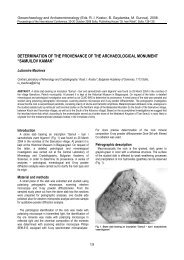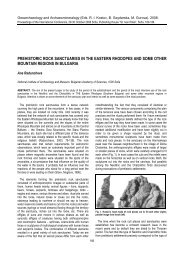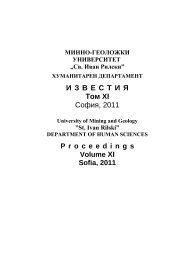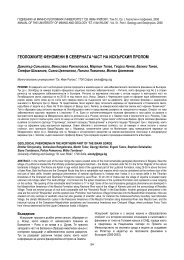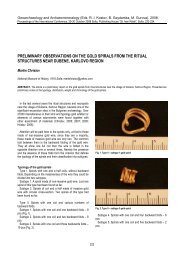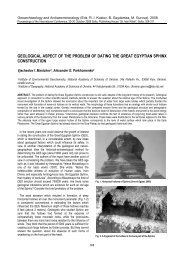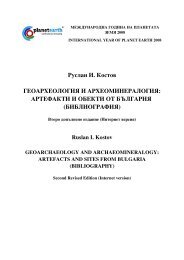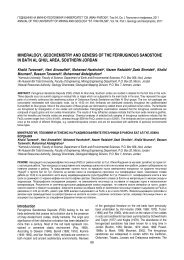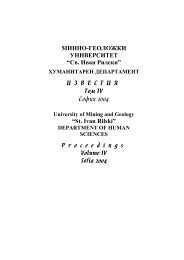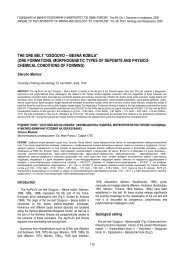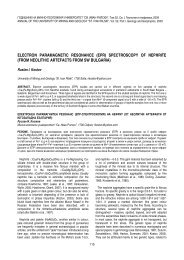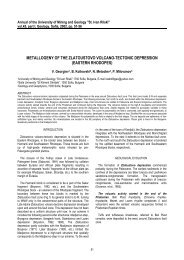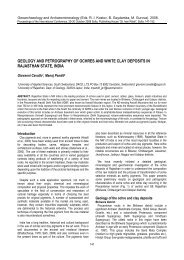FORMAL EARLY NEOLITHIC FLINT TOOLKITS ...
FORMAL EARLY NEOLITHIC FLINT TOOLKITS ...
FORMAL EARLY NEOLITHIC FLINT TOOLKITS ...
Create successful ePaper yourself
Turn your PDF publications into a flip-book with our unique Google optimized e-Paper software.
Fig. 9. Cryptocrystalline chalcedony and microcrystalline chalcedony –<br />
siliceous concretion; deposit Goliam Porovets – Chakmaka (near<br />
Isperih), sample N4, Low Cretaceous (Ludogorie flint – type Kriva Reka);<br />
transmitted light, crossed polars<br />
of the area – between the villages of Goliam Porovets,<br />
Drianovets, Krivnia, Chukata (Razgrad), Lisi Vrah, Kriva Reka<br />
and Rouzhitsa. The Ludogorie flint – Type Ravno is very often<br />
found as artefacts, especially in North-East Bulgaria (Rouse,<br />
Kamenovo, Ravno) and the Thracian valley (Ezero, Diadovo).<br />
The second type (Ludogorie flint – Type Kriva Reka) has a<br />
relatively low distribution as artefacts.<br />
In the Popovski Hills Region (Goranov, 1965) and at the<br />
Yantra River are described bedded siliceous rocks in vertical<br />
alternation with Aptian limestones. These bedded siliceous<br />
rocks altered laterally in Ludogorie flint to West direction and<br />
this flint is a possible raw material for artefacts production<br />
durring the Neolithic. Localities of such type are Golyamo<br />
Gradiste, Byala, Krepcha, Tsenovo, Beltsov and other sites.<br />
Moesian flint (К2 cp-m ). The silica concretions are hosted in the<br />
Upper Cretaceous (Campanian) chalk, chalk-like limestones<br />
and fine grained biomorphic limestones (Maastrichtian). In<br />
such a way they formed a few stratigraphic levels, but the very<br />
rich layer of flint is the Upper Campanian, where the<br />
concretions are condensed in a layer with approximately 1<br />
meter thickness. The colour of the concretions is brown, pale<br />
brown and grey, massive and spotted structure (brown with<br />
pale grey spots). Concentric-zonal structure is very rare. The<br />
size varies from 5 to 100 cm, mainly 15-35 cm, rarely up to 100<br />
cm. The shape is extremely irregular, with many branches<br />
(ameba-like). Macroscopic distinctive features are very often<br />
big relics from chalky limestones, sometime dissolved, with<br />
dimensions up to 10 cm. The crust is thin (1-2 mm), white,<br />
chalk contain, with silica-carbonate composition. The fracture<br />
is rough to smooth. The natural polish and yellow patina are<br />
typical for paleo and recent alluvial depositions. The mineral<br />
composition is a micro and crypto chalcedony (up to 75%),<br />
moganite (up to 25%), opal, quartz (2-3%) and framboidal<br />
pyrite. The microscopic observation shows micro to crypto<br />
groundmass and abundance of lightly fragmentated and<br />
chaotic distributed microfauna (Fig. 10). These microscopic<br />
features are diagnostic for Moesian flint. The Upper<br />
Cretaceous flint-rich rocks formed (Fig. 1) three large areas of<br />
outcrops in North Bulgaria (the Moesian Platform and<br />
adjustment parts of the Balkan Alpine Orogen), from West to<br />
Wast as follow: the first one between Montana and Lovech, the<br />
second – between Pleven and Nikopol and the third – between<br />
Shumen and Devnya.<br />
34<br />
Fig. 10. Cryptocrystalline chalcedony and microfauna filled with microcrystalline<br />
chalcedony – siliceous concretion; deposit Somovit (near<br />
Nikopol), sample N11a, Upper Cretaceous (Moesian flint); transmitted<br />
light, crossed polars<br />
In this big territory Moesian flint has large distribution and<br />
has formed big deposits. Throughout this big area the Moesian<br />
flint has similar features. Only in the Pleven-Nikopol region the<br />
Moesian flint is hosted in non deformed rocks. That is why the<br />
flint from these outcrops has a better quality. This fact and the<br />
convenient transport connection along the Danube River,<br />
determined the big outcrops on the Danube cost near Nikopol<br />
and Somovit, as the most probable source of flint raw materials<br />
for vast territories in Serbia and Romania.<br />
Sredna Gora atypical flint (K2 Cn-Cp ) is represented as<br />
hydrothermal veins from chalcedony varieties in the Upper<br />
Cretaceous volcanogenous rocks (of Coniacian, Santonian and<br />
Campanian ages) in the Sredna Gora paleovolcanic zone. This<br />
atypical flint (Fig. 1) forms a few deposits, but with a large<br />
geographic distribution in the Thracian Plain. Because of the<br />
strong tectonic treatment, its irregular shape and domain of<br />
recrystallization, this material (only as local source) has a very<br />
small participation in artefacts production.<br />
The Rhodopes atypical flint (Pg3) is represented as<br />
hydrothermal veins of chalcedony varieties (chalcedony, agate<br />
and jasper) in the Oligocene volcanogenic rocks in the<br />
Rhodopes Zone. The Rhodopes atypical flint has a large<br />
geographic distribution in the Eastern and Central Rhodopes<br />
and has formed a large deposition. A few of these deposits<br />
(near Asenovgrad, Chirpan and Haskovo) are distributed in the<br />
Thracian Plain. This fact determines their participation in flint<br />
toolkits in Thrace. The atypical flint from the Rhodopes zone,<br />
because of its irregular shape, many inclusions, domains of<br />
recrystallization, tectonic treatment and other peculiarities has<br />
significance only as a local source of flint durring the Neolithic<br />
and Chalcolithic.<br />
The microscopic examinations of artefacts, despite their<br />
preliminary character give the following clear suggestions: the<br />
flint toolkits in the Central West Bulgaria are with significant<br />
participation (up to 90%) of Moesian flint (Chavdar and<br />
Kazanluk sites); there are evidences for participation of<br />
Moesian flint in the Rakitovo site in the Rhodope Region; the<br />
Kovachevo site (Struma valley) in conditions of total lack of<br />
local flint sources is characterized with participation of<br />
Ludogorie flint – 2% (for formal toolkits) and up to 50% of the<br />
Rhodopes atypical flint with probable source from the Batak-<br />
Dospat region.



